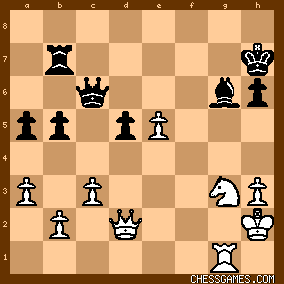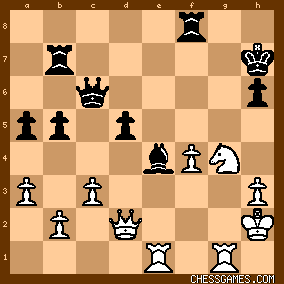wayneduhpatzer: [CONTINUATION of my earlier post]
<2]> 39 Ng3 might have either of two intentions: either to simply trade off on e4, or to play Nh5 hoping to create combinational motifs on the dark squares around Black’s King. And if Black tries to meet both of these possibilities by responding 39..Bg6 (diagram) – I don’t know if this is best; Black surely has other options (again, too many to analyze) – White can consider two replies: 
click for larger view
(position after 39..Bg6 in above analysis)
<2A]> 40 Re5 (hitting the d-pawn and preparing to double Rooks) and if ..Rxe5 41 fxe5 (diagram); I had thought White’s advantage might be growing ever so slightly, but after 41..b4 now I’m not so sure. 
click for larger view
(position after 41 fxe5 in above analysis)
<2B]> 40 f5 Bf7 and then maybe 41 Qd4 (or Qf4); or, to keep Black from replying 41..Rbe7 and thus keeping control of the e-file, perhaps White should swap Rooks first, 41 Rxe8 Qxe8 42 Re1 (diagram) and if ..Re7 (or should Black play ..Qb8 or ..Qf8 to aim for the ..b4-break?), then 43 Rxe7 Qxe7 and now maybe 44 Qd4 (or Qf4). 
click for larger view
(position after 42 Re1 in above analysis)
<3]> A third option is 39 Ne3 (with the idea of going via g4 to e5). Now, it appears 39..Rf7? could be met by 40 Nxd5 (I can’t find how Black refutes it or gets comp for it); and it looks like 39..b4 would also drop a pawn in similar fashion after 40 axb4 axb4 41 Nxd5. Thus Black’s best move seems to be 39..Rf8. Then White plays 40 Ng4 (second diagram below). Now Black can’t play 40..Rbf7? (41 Ne5), nor 40..Qd6? (41 Rxe4). A third move to consider, 40..Qc7 (same idea as ..Qd6, to pressure the f-pawn, but without the flaw of dropping a piece), just “looks” too slow – firstly because it keeps the Rook on b7 from joining the action on the Kingside; and secondly because, after 41 Ne5, Black seems not quite ready to initiate Queenside counterplay by 41..b4, due to 42 axb4 axb4 43 c4! (diagram; and if ..Qc5 44 b3). 
click for larger view
(position after 43 c4! in above analysis)
So after 40 Ng4 (diagram) best seems either:

click for larger view
(position after 40 Ng4 in above analysis)
<3A]> immediate Queenside counterplay by 40..b4; this might continue either 41 cxb4 axb4 42 Ne5 Qf6, or 41 axb4 axb4 42 Rg3 Rf5 43 Ne5 Qf6; or, <3B]> 40..Rg7; and this might continue 41 Ne5 Qf6. My reason for glancing at all these lines (in which White stands just a bit better, as he should, with his extra pawn) is just to give samples of the various ways White might’ve tried to handle this position and hopefully increase his slight edge. But instead White bombed with 39 Qd4?? Bxf5, dropping a piece, and after 40 Rxe8 Qxe8 41 Qxd5 Qf7 he resigned soon thereafter. PITY! | 




